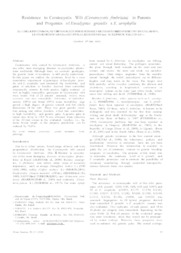Resistance to ceratocystis wilt (Ceratocystis fimbriata) in parents and progenies of Eucalyptus grandis x E. urophylla.
Resistance to ceratocystis wilt (Ceratocystis fimbriata) in parents and progenies of Eucalyptus grandis x E. urophylla.
Author(s): ROSADO, C. C. G.; GUIMARÃES, L. M. da S.; TITON, M.; LAU, D.; ROSSE, L.; RESENDE, M. D. V. de; ALFENAS, A. C.
Summary: Ceratocystis wilt, caused by Ceratocystis fimbriata, is one ofthe most damaging diseases in eucalyptus plantations worldwide. Although there are resistant genotypes, the genetic basis of resistance is still poorly understood. In this paper we studied the resistance leveI by a stem inoculation experiment of genotypes of Eucalyptus grandis and E. urophylla and estimated the heritability and gains of selection in families derived from controlled interspecific crosses. In both species, highly resistant as well as highly susceptible genotypes to Ceratocystis wilt were found. Out of 21 parents assessed, twelve were resistant and nine susceptible. Estimates of individual narrow (50%) and broad (59%) sense heritability suggested a high degree of genetic control and low allelic dominance of the trait. There was great genetic variation among and within families, a fact that contributes to high heritability and genetic gain. A genetic gain in lesion size of up to -74.4 % was obtained from selection of the 50 best clones in the evaluated families, i.e., the mean lesion length in the progeny population can be reduced by 74,4%.
Publication year: 2010
Types of publication: Journal article
Unit: Embrapa Forestry
Keywords: Ceratocystis Fimbriata, Doença, Eucalipto, Resistência
Observation
Some of Embrapa's publications are published as ePub files. To read them, use or download one of the following free software options to your computer or mobile device. Android: Google Play Books; IOS: iBooks; Windows and Linux: Calibre.
Access other publications
Access the Agricultural Research Database (BDPA) to consult Embrapa's full library collection and records.
Visit Embrapa Bookstore to purchase books and other publications sold by Embrapa.

